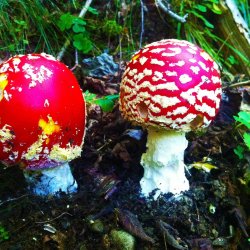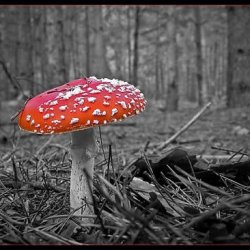UNVEILING THE MYSTIC SECRETS: CULTIVATING AMANITA MUSCARIA

Unveiling the Mystic Secrets: Cultivating Amanita Muscaria
Welcome to the mystical world of Amanita Muscaria cultivation! If you’ve ever been captivated by the enchanting allure of this unique mushroom, you’re in for a treat. In this article, we will delve into the age-old art of growing Amanita Muscaria and explore the secrets behind its cultivation. Whether you are a seasoned cultivator or an enthusiastic beginner, this guide will equip you with the knowledge you need to successfully nurture this intriguing, yet elusive fungus.
Growing Amanita Muscaria indoors can be a rewarding and immersive experience. Not only does it provide an opportunity to observe the fascinating life cycle of this species up close, but it also allows for precise control over environmental factors essential for optimal growth. From selecting the right substrate to creating the ideal growing conditions, we will unveil the essential steps required to cultivate Amanita Muscaria in the comfort of your own home.
One common question that arises when venturing into the world of Amanita Muscaria cultivation is: How long does it take for these mushrooms to grow? Patience is key when it comes to growing Amanita Muscaria, as their life cycle can span several months. However, with the right techniques and a sprinkle of patience, you will soon witness the magical emergence of these iconic red and white caps.
Numerous studies have been conducted on Amanita Muscaria, shedding light on its fascinating properties and potential benefits. From its historical and cultural significance to its psychoactive compounds, researchers have delved into various aspects of this enigmatic mushroom. In this study, we will explore some of the most notable findings and delve into the wealth of knowledge that has been amassed about Amanita Muscaria.
Get ready to embark on a journey of discovery as we unveil the secrets behind successfully cultivating Amanita Muscaria. Join us as we delve into the art of growing this remarkable mushroom indoors, explore its fascinating life cycle, and delve into the captivating research that has enhanced our understanding of Amanita Muscaria. Let’s unlock the mystic secrets together and bring the magic of Amanita Muscaria cultivation into our lives.
Growing Amanita Muscaria Indoors
In this section, we will explore the process of growing Amanita Muscaria indoors. Cultivating these mystical mushrooms can be a rewarding experience for enthusiasts and researchers alike. Below, we will discuss the necessary steps to successfully grow Amanita Muscaria in the comfort of your own home.
Choosing the Right Environment
When growing Amanita Muscaria indoors, it’s essential to recreate the ideal environment for their growth. These mushrooms thrive in cooler temperatures, usually between 65°F to 75°F (18°C to 24°C). Additionally, they require indirect sunlight or a well-controlled artificial light source. Creating a dedicated space with proper temperature control and lighting will promote healthy growth.
Creating the Growing Medium
To cultivate Amanita Muscaria, you’ll need to prepare a suitable growing medium. These mushrooms have a symbiotic relationship with certain tree species, such as birch and pine trees. One common approach is to mix sawdust, ideally from birch or pine, with spawn or mycelium. This mixture provides the necessary nutrients for the mushrooms to develop.
Implementing Proper Care
Once you have prepared the growing medium, it’s crucial to provide the necessary care for your Amanita Muscaria. Maintaining the appropriate moisture level is vital for their growth. Mist the growing medium regularly, ensuring it remains damp but not excessively wet. Additionally, ensuring good air circulation and proper ventilation is essential to prevent the development of mold or bacteria.

Stay tuned for the next section, where we will delve into the timeline of Amanita Muscaria’s growth cycle and explore the fascinating studies and research conducted on these magical mushrooms.
Timeline of Amanita Muscaria Growth
In order to successfully cultivate Amanita Muscaria, it is essential to understand the timeline of its growth. From the initial stages of preparation to the eventual harvest, here is an overview of the process involved in growing this mystical fungus indoors.
Stage 1: Preparing the Growth Medium
Before embarking on the journey of growing Amanita Muscaria, it is crucial to create a suitable environment for its growth. This study suggests using a mixture of sterilized wood-based substrate, such as straw or wood chips, coupled with a blend of peat moss and vermiculite. This combination provides the ideal conditions for the mycelium to thrive and spread its magical network.
Stage 2: Propagation and Germination
Once the growth medium is prepared, it’s time to inoculate it with Amanita Muscaria spores or mycelium. This study recommends using a spore syringe or obtaining mycelium from a trusted source. Placing the inoculated substrate in a dark and warm environment, preferably around 70-80°F (21-27°C), the spores will germinate and the mycelium will begin its journey, colonizing the substrate.
Stage 3: Maturation and Fruit Body Development
As the mycelium continues to grow and colonize the substrate, it will eventually reach a stage where it is ready to produce the characteristic fruit bodies, commonly known as the fly agaric mushrooms. The mycelium will start forming primordial mushroom pins, which will eventually develop into fully mature Amanita Muscaria mushrooms. Studies have shown that it takes an average of 6-8 weeks for the mushrooms to fully develop, depending on the environmental conditions provided.
Keeping a close watch on the progress of the grow, ensuring the right balance of temperature, humidity, and airflow, is vital to successful cultivation. Following this timeline and being patient throughout the process will reward cultivators with their very own enchanting Amanita Muscaria mushrooms, ready to be admired and appreciated for their mystical qualities.
Note: The information provided is based on research and studies conducted on Amanita Muscaria. It is important to approach the cultivation of this species responsibly and adhere to any legal regulations governing its cultivation in your region.
Current Studies and Research on Amanita Muscaria
Amanita Muscaria, commonly known as the fly agaric, has long captivated the attention of researchers and enthusiasts alike. Let’s delve into some of the current studies and research being conducted on this intriguing fungus.
-
- The Growth Process: To truly understand how to grow Amanita Muscaria, it’s important to explore the research on its growth process. Scientists have been studying the life cycle and optimal conditions required for successful cultivation of this mushroom. study about amanita muscaria as temperature, humidity, and substrate composition are being investigated in order to develop effective cultivation techniques.
-
- Indoor Cultivation: One area of particular interest is the cultivation of Amanita Muscaria indoors. Researchers are exploring innovative methods and technologies to recreate the natural environment necessary for its growth within controlled settings. These studies aim to provide valuable insights into creating optimal indoor conditions, including artificial light sources and controlled microclimates.
-
- Chemical Composition and Effects: Another significant aspect of research on Amanita Muscaria revolves around its chemical composition and potential effects. Researchers are analyzing the various compounds present in the mushroom, such as ibotenic acid and muscimol, to better understand their psychoactive properties. These studies contribute to our knowledge of how Amanita Muscaria interacts with the human body and its potential applications in medicine and neuroscience.
In conclusion, ongoing studies and research on Amanita Muscaria shed light on its growth process, indoor cultivation techniques, and chemical composition. These endeavors not only deepen our understanding of this mysterious fungus but also open doors to new possibilities in various fields of study.





